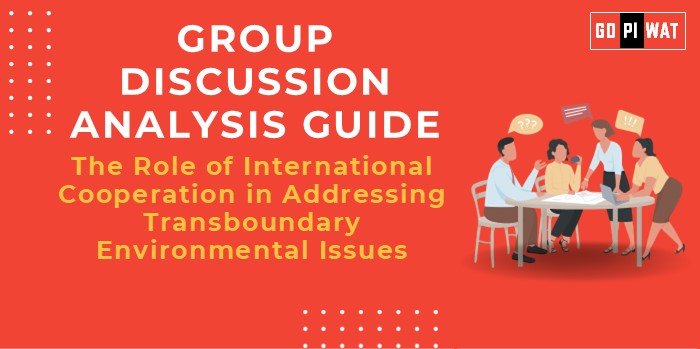📋 Group Discussion Analysis Guide: The Role of International Cooperation in Addressing Transboundary Environmental Issues
🌐 Introduction to the Topic
🔍 Opening Context:
Climate change, pollution, and biodiversity loss transcend national borders, making international cooperation indispensable for sustainable solutions.
📜 Topic Background:
From the 1987 Montreal Protocol to the Paris Agreement of 2015, collaborative efforts have showcased the global community’s ability to tackle environmental issues collectively. Recent incidents, such as cross-border plastic pollution and shared water resource conflicts, underscore the importance of multilateral frameworks.
📊 Quick Facts and Key Statistics
- 🌊 Global Plastic Pollution: Over 11 million tons of plastic waste enter oceans annually, much of it crossing international waters.
- 🌳 Deforestation Impact: Amazon Basin deforestation affects the global oxygen supply, contributing to 20% of annual global CO₂ emissions.
- 🦋 Biodiversity Loss: One million species face extinction, with migratory animals particularly affected by habitat destruction across countries.
- 🌍 Climate Change Costs: Economic damages from extreme weather events surpassed $165 billion in 2022, affecting multiple nations simultaneously.
🤝 Stakeholders and Their Roles
- 🏛️ Governments: Create and enforce treaties like the Paris Agreement.
- 🌐 International Organizations: Facilitate dialogue and funding (e.g., UN, World Bank).
- 🏢 Corporations: Implement sustainable practices in global supply chains.
- 🌱 Non-Governmental Organizations (NGOs): Advocate and raise awareness.
- 👨👩👧👦 Citizens and Activists: Drive grassroots movements and influence policy.
🏆 Achievements and Challenges
✨ Achievements:
- 🌏 Montreal Protocol: Successfully phased out 99% of ozone-depleting substances.
- 🌲 Global Deforestation Initiatives: Brazil’s reforestation reduced carbon emissions by 37% between 2010 and 2020.
- 🔋 Renewable Energy Growth: Global renewable energy use rose by 8% in 2022, thanks to international collaborations.
⚠️ Challenges:
- ⚖️ Unequal Participation: Many developing countries lack the resources to meet international standards.
- 💼 Political Conflicts: Countries often prioritize short-term economic gains over environmental commitments.
- 🔍 Enforcement Gaps: Weak penalties for non-compliance hinder progress.
🧠 Structured Arguments for Discussion
✔️ Supporting Stance:
“Global initiatives like the Paris Agreement prove that collective action can mitigate transboundary environmental threats effectively.”
❌ Opposing Stance:
“International cooperation often fails due to unequal participation and insufficient enforcement.”
⚖️ Balanced Perspective:
“While significant progress is visible, gaps in compliance and equitable resource allocation need urgent attention.”
💬 Effective Discussion Approaches
🎯 Opening Approaches:
- 📊 Use recent statistics on climate-induced disasters to establish urgency.
- 🌏 Refer to successful treaties like the Montreal Protocol to inspire optimism.
- 🌳 Highlight gaps using examples like the Amazon deforestation crisis.
🛡️ Counter-Argument Handling:
- 🌟 Acknowledge challenges in enforcement but cite advancements in renewable energy as proof of capability.
- 📚 Use global case studies to demonstrate the potential of shared accountability.
📈 Strategic Analysis of Strengths and Weaknesses
- ✅ Strengths: Collective expertise, resource pooling, global solidarity.
- ⚠️ Weaknesses: Enforcement gaps, political conflicts.
- 🌟 Opportunities: Development of green technology, multilateral funding.
- 🔴 Threats: Climate denialism, uneven policy enforcement.
🎓 Connecting with B-School Applications
💼 Real-World Applications:
- 📋 Ideal for projects on global supply chain sustainability or ESG (Environmental, Social, Governance) policies.
💡 Sample Questions:
- 💬 “How can businesses contribute to international environmental treaties?”
- 🌐 “Analyze the role of UN bodies in transboundary pollution control.”
🌱 Insights for Students:
- 🔍 Collaborative problem-solving and adaptability are key managerial skills emphasized by such topics.


